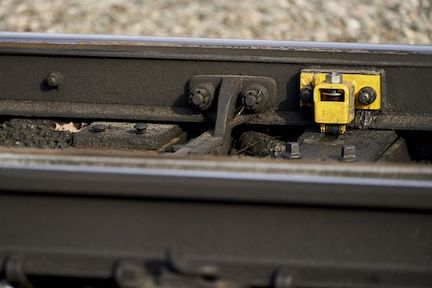The railroad sensors that failed to detect an overheated bearing in time to prevent the Ohio train derailment and toxic spill use antiquated technology and have a mixed record of preventing accidents.
Government reports, academics and decades of research indicate that the heat sensors deployed across thousands of miles of railroads in the US and other nations are prone to false alarms and inferior to more modern techniques being adopted by other industries using heavy machinery, from jet engines to wind turbines.
The spectacular Ohio derailment has put a spotlight on the little-known network of sensors across US railroads designed to prevent just these type of accidents. The devices were functioning that night, but the overheat warning came too late.

There were 151 serious derailments during a 10-year span through 2018 in the US and Canada in which the sensors didn’t prevent a failing wheel bearing, according to a study co-authored by Tarawneh, who has licensed technology for use in wheel sensors.
There have been five other such cases since 2021, including two on Norfolk Southern Corp., the operator of the train in Ohio, the Federal Railroad Administration said this week in a safety advisory calling on railroads to improve how they use the sensors.
So-called hot box or hot bearing detectors are a focus of the Feb. 3 train wreck in East Palestine, Ohio, that led to the release of toxic chemicals and has created a political firestorm.
Investigators are looking at how the sensors functioned in the accident and whether the standards for their use are adequate, National Transportation Safety Board Chairwoman Jennifer Homendy said in a recent briefing. The sensors aren’t required under federal law, and railroads use a variety of different standards, Homendy said.
“Roller bearings fail, but it’s absolutely critical for problems to be identified and addressed early, so these aren’t run until failure,” she said.
The railroad industry has defended the devices, saying they have helped reduce accidents. While a coalition including railcar makers, shippers and two large railroads is testing better monitoring equipment, deploying them to the more than 1.6 million freight cars in North America would cost huge sums, they say.
Existing sensor technology is “nothing fancy, but it’s been able to be leveraged in a way that has kept the industry safe,” said Kari Gonzales, president and chief executive officer of MxV Rail, the testing arm of the American Association of Railroads.
In Ohio, a bearing on one of the rail car’s wheels failed, causing it to overheat and break apart, according to the NTSB. The rail car then jumped the tracks and pulled multiple other cars with it in a violent chain reaction.
The car had passed two of the detectors — which face upward, scanning bearings as trains pass above to measure heat — in the 30 miles (48 kilometers) before the mishap. Even though the bearing’s heat was rising and reached 103 degrees above the ambient temperature on the second sensor about 19 miles from the accident, that was not considered sufficient to warn the train’s engineers, according to the NTSB.
A third sensor recorded the bearing’s temperature at 253 degrees above the outside air and sounded an alarm, prompting the crew to brake, but it was too late.
Because the heat sensors are prone to false readings, railroads wait for high spikes in temperature to avoid unwaranted alarms that would require costly halts for inspections, according to Tarawneh’s research.
Moreover, a damaged bearing may only reach high temperatures in the final minutes before breaking apart, so periodically monitoring temperature along the track won’t catch some failures in time, according to Tarawneh and three other mechanical engineers specializing in bearing monitoring.
“By the time you detect it, the condition could be very bad,” said Jay Lee, a University of Maryland professor who’s spent decades studying a field known as intelligent maintenance.
Railroads in North America have installed more than 6,000 of the heat detectors, and they are credited with helping reduce accidents linked to bearing and axle failures by 81% since 1980, according to the US Department of Transportation.
But multiple studies and accident reports show that they are far from perfect.
A Canadian Pacific Railway freight train that derailed in Ontario in 2013 due to a wheel bearing failure passed five detectors without any indication of overheating, Canada’s Transportation Safety Board found.
A car on a Norfolk Southern train derailed in Georgia on July 12 despite multiple sensors reporting an overheated bearing two days earlier, according to the FRA.
In recent decades, industries relying on heavy bearings have increasingly begun using sophisticated vibration or acoustic monitoring devices because they are more useful than heat sensing alone, said Sam Anand, a mechanical engineering professor at the University of Cincinnati.
“Any expensive modern machinery you see on the factory floor, they all have embedded sensors,” Anand said.
Tarawneh has licensed technology to a company, Hum Industrial Technology Inc., that makes such sensors specifically for rail car wheels.
However, even advocates for improved safety say that the federal rules on enacting new regulations make it difficult to justify new protections, and the railroad industry’s structure creates additional challenges.
Freight rail cars don’t have electrical power, for example, and won’t anytime soon since President Donald Trump’s administration rescinded a requirement for hazardous trains to have newer electric brakes. That will make the addition of new sensors more challenging, according to Robert Lauby, the FRA’s former chief safety officer who previously served as an investigator with NTSB.
Adding more sophisticated technology to freight cars is “how you get to a safer railroad,” Lauby said. “When and how you get to that place I don’t know right now. There are hurdles everywhere.”







